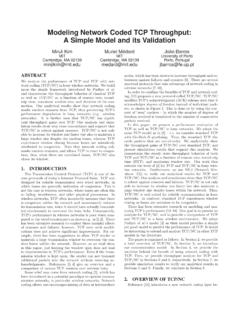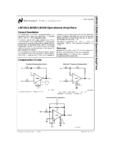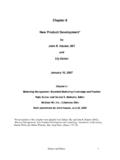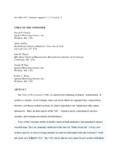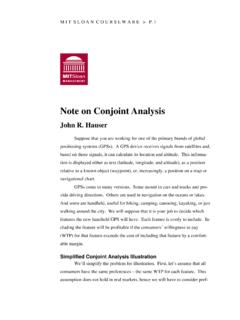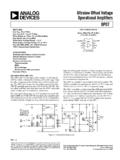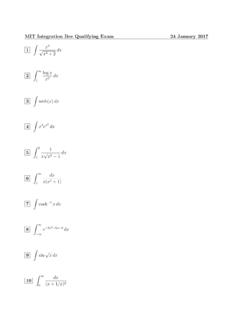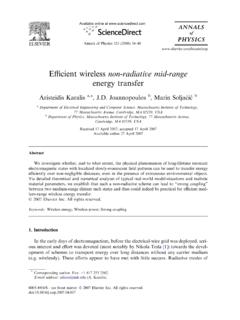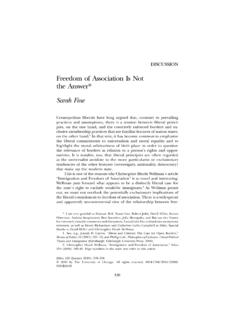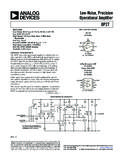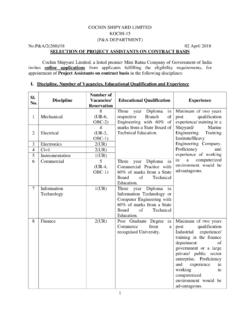Transcription of CHAPTER 1 The Physiological Basis of the Electrocardiogram
1 P1: ShashiAugust 24, 200611:34 Chan-HorizonAzuaje BookCHAPTER 1 The Physiological Basis of theElectrocardiogramAndrew T. Reisner, Gari D. Clifford, and Roger G. MarkBefore attempting any signal processing of the Electrocardiogram it is importantto first understand the Physiological Basis of the ECG, to review measurementconventions of the standard ECG, and to review how a clinician uses the ECGfor patient care. The material and figures in this CHAPTER are taken from [1, 2], towhich the reader is referred for a more detailed overview of this subject. Furtherinformation can also be found in the reading list given at the end of this heart is comprised of muscle (myocardium) that is rhythmically driven tocontract and hence drive the circulation of blood throughout the body.
2 Before everynormal heartbeat, orsystole,1a wave of electrical current passes through the entireheart, which triggers myocardial contraction. The pattern of electrical propagationis not random, but spreads over the structure of the heart in a coordinated patternwhich leads to an effective, coordinated systole. This results in a measurable changein potential difference on the body surface of the subject. The resultant amplified(and filtered) signal is known as an Electrocardiogram (ECG, or sometimes EKG).A broad number of factors affect the ECG, including abnormalities of cardiac con-ducting fibers, metabolic abnormalities (including a lack of oxygen, orischemia)of the myocardium, and macroscopic abnormalities of the normal geometry of theheart.
3 ECG analysis is a routine part of any complete medical evaluation, due to theheart s essential role in human health and disease, and the relative ease of recordingand analyzing the ECG in a noninvasive the Basis of a normal ECG requires appreciation of four phe-nomena: the electrophysiology of a single cell, how the wave of electrical currentpropagates through myocardium, the physiology of the specific structures of theheart through which the electrical wave travels, and last how that leads to a mea-surable signal on the surface of the body, producing the normal Cellular Processes That Underlie the ECGEach mechanical heartbeat is triggered by anaction potentialwhich originates froma rhythmic pacemaker within the heart and is conducted rapidly throughout the or-gan to produce a coordinated contraction.
4 As with other electrically active , the opposite of systole, is defined to be the period of relaxation and expansion of the heartchambers between two contractions, when the heart fills with : ShashiAugust 24, 200611:34 Chan-HorizonAzuaje Book2 The Physiological Basis of the ElectrocardiogramFigure typical action potential from a ventricular myocardial cell. Phases 0 through 4 aremarked. (From: [2].c 2004 MIT OCW. Reprinted with permission.)( , nerves and skeletal muscle), the myocardial cell at rest has a typical trans-membrane potential,Vm, of about 80 to 90 mV with respect to surroundingextracellular cell membrane controls permeability to a number of ions,including sodium, potassium, calcium, and chloride.
5 These ions pass across themembrane through specific ion channels that can open (become activated) andclose (become inactivated). These channels are therefore said to begatedchannelsand their opening and closing can occur in response to voltage changes (voltagegated channels) or through the activation of receptors (receptor gated channels).The variation of membrane conductance due to the opening and closing of ionchannels generates changes in the transmembrane (action) potential over time. Thetime course of this potential as it depolarizes and repolarizes is illustrated for a ven-tricular cell in Figure , with the five conventional phases (0 through 4) cardiac cells are depolarized to athresholdvoltage of about 70 mV ( ,by another conducted action potential), there is a rapid depolarization (phase 0 the rapid upstroke of the action potential) that is caused by a transient increasein fast sodium channel conductance.
6 Phase 1 represents an initial repolarizationthat is caused by the opening of a potassium channel. During phase 2 there is anapproximate balance between inward-going calcium current and outward-goingpotassium current, causing a plateau in the action potential and a delay in repolar-ization. This inward calcium movement is through long-lasting calcium channelsthat open up when the membrane potential depolarizes to about 40 mV. Repo-larization (phase 3) is a complex process and several mechanisms are thought tobe important. The potassium conductance increases, tending to repolarize the cellvia a potassium-mediated outward current.
7 In addition, there is a potentials may be recorded by means of : ShashiAugust 24, 200611:34 Chan-HorizonAzuaje Cellular Processes That Underlie the ECG3decrease in calcium conductivity which also contributes to cellular 4, the resting condition, is characterized by open potassium channels and thenegative transmembrane potential. After phase 0, there are a parallel set of cellularand molecular processes known asexcitation-contraction coupling: the cell s depo-larization leads to high intracellular calcium concentrations, which in turn unlocksthe energy-dependent contraction apparatus of the cell (through a conformationalchange of the troponin protein complex).
8 Before the action potential is propagated, it must be initiated bypacemakers,cardiac cells that possess the property ofautomaticity. That is, they have the abilityto spontaneously depolarize, and so function as pacemaker cells for the rest of theheart. Such cells are found in the sino-atrial node (SA node), in the atrio-ventricularnode (AV node) and in certain specialized conduction systems within the atria automatic cells, the resting (phase 4) potential is not stable, but showsspontaneous depolarization: its transmembrane potential slowly increases towardzero due to a trickle of sodium and calcium ions entering through the pacemakercell s specialized ion channels.
9 When the cell s potential reaches a threshold level,the cell develops an action potential, similar to the phase 0 described above, butmediated by calcium exchange at a much slower rate. Following the action potential,the membrane potential returns to the resting level and the cycle repeats. There aregraded levels of automaticity in the heart. The intrinsic rate of the SA node ishighest (about 60 to 100 beats per minute), followed by the AV node (about 40 to50 beats per minute), then the ventricular muscle (about 20 to 40 beats per minute).Under normal operating conditions, the SA node determines heart rate, the lowerpacemakers being reset during each cardiac cycle.
10 However, in some pathologiccircumstances, the rate of lower pacemakers can exceed that of the SA node, andthen the lower pacemakers determine overall heart action potential, once initiated in a cardiac cell, will propagate along thecell membrane until the entire cell is depolarized. Myocardial cells have the uniqueproperty of transmitting action potentials from one cell to adjacent cells by means ofdirect current spread (without electrochemical synapses). In fact, until about 1954there was almost general agreement that the myocardium was an actual syncytiumwithout separate cell boundaries.
